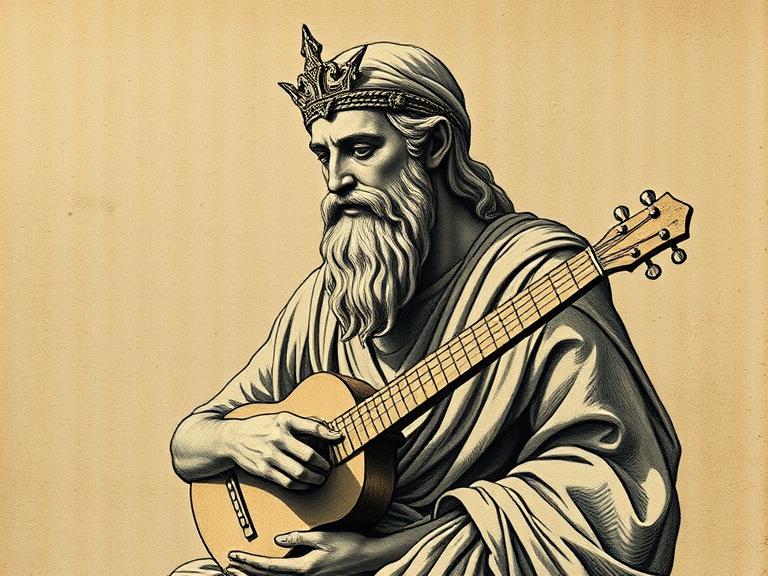
Music and Mathematics
Share
How Music and Mathematics Connect Through Ancient Wisdom
Published by Pyramason Team | Ancient Mysteries, Music, Sacred Geometry
At Pyramason, we believe that music and mathematics share a profound connection that ancient civilizations understood far better than we often realize today. This understanding bridges our two worlds: the analytical tools we use to decode ancient mysteries and the music-inspired apparel that funds our research. Let's explore how sound, number, and sacred geometry intertwine across cultures and millennia.
The Harmony of Numbers: Pythagoras and Musical Mathematics
The ancient Greek philosopher Pythagoras discovered that musical harmony follows precise mathematical ratios. When he struck a blacksmith's hammers of different weights, he noticed that pleasing combinations followed simple numerical relationships:
- Octave: 2:1 ratio (double the frequency)
- Perfect Fifth: 3:2 ratio
- Perfect Fourth: 4:3 ratio
These weren't arbitrary discoveries—they represented universal principles that ancient cultures worldwide seemed to understand intuitively.
Ancient Temples as Musical Instruments
Many ancient structures were designed with acoustic properties that suggest their builders understood sound mathematics:
The Great Pyramid of Giza resonates at a frequency of 110 Hz when struck, matching the fundamental frequency found in many ancient chants and sacred songs.
Newgrange in Ireland amplifies certain frequencies while dampening others, creating a natural sound chamber that may have been used for ritualistic purposes.
The Temple of Kukulkan at Chichen Itza produces a chirping sound that mimics the quetzal bird when visitors clap at its base—a deliberate acoustic engineering feat.
The Mathematical Beauty of Musical Scales
Ancient civilizations developed musical scales based on mathematical principles that mirror the geometric ratios found in their architecture:
Egyptian Scale Systems: Used intervals that correspond to the golden ratio proportions found in pyramid construction.
Chinese Pentatonic Scale: Based on the mathematical relationship between the five elements, with intervals that reflect cosmic harmony principles.
Indian Raga System: Incorporates microtonal variations calculated using precise mathematical formulas that create specific emotional and spiritual effects.
Sacred Geometry in Sound Waves
When we visualize sound waves, we discover geometric patterns that mirror those found in ancient architecture:
- Cymatic Patterns: Sound frequencies create geometric shapes in sand or water that resemble mandala designs found in ancient temples
- Standing Wave Ratios: Musical intervals create geometric relationships identical to those used in sacred architecture
- Resonance Chambers: Ancient structures often incorporate geometric proportions that enhance specific frequencies
Modern Music, Ancient Wisdom
Today's musicians still unconsciously follow these ancient mathematical principles. Consider how:
Album Cover Art often incorporates geometric patterns that unknowingly echo ancient sacred designs—inspiration for our music-themed apparel collections.
Digital Audio Production relies on the same frequency ratios that ancient civilizations used in their ceremonial music.
Concert Hall Design applies acoustic geometry principles developed in ancient amphitheaters and temples.
The Pyramason Connection: Where Music Meets Mystery
Our music-inspired apparel collections aren't just fashion statements—they represent the intersection of these ancient wisdom traditions:
Each design in our musical collections incorporates geometric elements that reflect both the mathematical beauty of music and the sacred geometry found in ancient sites. When you scan the Spotify codes on our products, you're not just discovering great music—you're participating in the same tradition of pattern recognition that helped ancient architects design their monuments.
Decoding Musical Architecture
Using Pyramason's analysis tools, you can explore how ancient sites incorporate musical mathematics:
- Measure Chamber Dimensions: Many ancient structures use room proportions that match musical intervals
- Analyze Acoustic Properties: Study how geometric design affects sound resonance
- Compare Global Patterns: Identify mathematical relationships between music and architecture across cultures
- Map Sound Landscapes: Explore how ancient sites were positioned to work with natural acoustic phenomena
The Universal Language
What emerges from studying music and ancient architecture together is evidence of a universal mathematical language—one that ancient civilizations used to create both beautiful sounds and awe-inspiring structures.
This same language appears in:
- The spiral patterns of galaxy formation
- The growth patterns of plants and shells
- The orbital relationships of planets
- The frequency patterns of human brainwaves
Practical Applications for Modern Mystery Seekers
You can explore these connections yourself:
Listen Geometrically: When enjoying music, consider the mathematical relationships creating the harmony you're experiencing.
Measure Musically: Use musical interval ratios as a tool for analyzing ancient site proportions.
Create Consciously: Whether making music or art, incorporate the geometric principles our ancestors understood.
Connect Communities: Join our growing network of people who see the connections between ancient wisdom and modern creativity.
Supporting Discovery Through Design
Every piece in our music-inspired collections helps fund the development of tools that let researchers and enthusiasts explore these connections. When you wear Pyramason, you're not just appreciating great design—you're supporting the investigation of humanity's greatest mysteries.
The mathematical relationships that created the world's most beautiful music are the same ones that guided the construction of humanity's most enduring monuments. By understanding these connections, we gain insight into both our creative potential and our ancient heritage.
Ready to explore the intersection of music and ancient mysteries? Check out our music-inspired collections and use our interactive tools to discover the geometric relationships hidden in both sound and stone.
What connections do you notice between music and mathematics in your own life? Share your insights and join our community of modern mystery seekers.
